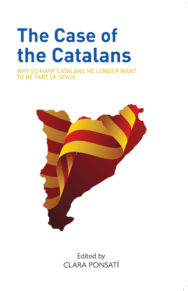‘The perception that further autonomy was not possible within Spain, and the trend towards recentralisation by Spanish central authorities led a large number of Catalan voters to shift towards demanding full independence.’
The Case of the Catalans lays out the historical, legal, political and economic aspects behind the present conflict between Catalonia and Spain, exploring why so many Catalans are no longer happy to be part of Spain. This extract presents a summary of the growing popularity of the independence movement, and a timeline of events that shows how the relationship between Catalonia and Spain has changed over the years.
Extract taken from The Case of the Catalans: Why So Many Catalans No Longer Want to be Part of Spain
Edited by Clara Ponsati
Published by Luath Press
The reasons behind the surge in support for independence
While for many in the international arena the Catalan pro-independence demands are new, secessionist groups have existed in Catalonia for at least the last 100 years. However, for the larger part of that period, explicitly pro-independence positions were never dominant within Catalan nationalism.
This is especially true for the post-Francoist period. Ever since the restoration of democracy in 1978, mainstream Catalan nationalism has sought compromise with Spain in order to achieve a gradual increase in devolved powers, rather than full separation. Even the parties that had self-determination and independence in their manifestos took part in the compromise strategy, and sought negotiations for increased autonomy.
This was congruent with the preferences of the population. When asked by the CEO, the Catalan Centre for Opinions, about their preferred constitutional arrangement in 2006, only 14 per cent of respondents chose secession as their first preference among four options – centralisation, status quo, federalism or secession. However, when the same poll repeated the question in 2013, the number had skyrocketed to 48.5 per cent, stabilising later on around 40 per cent. When asked directly about their vote in a potential referendum, around 50 per cent declared that they would favour independence.
However, this abrupt change obscures a more stable feature of Catalan public opinion: even if often falling short of demanding full independence, a majority of Catalan citizens have favoured full decentralisation ever since autonomous institutions were restored. This widespread demand for more autonomy was already over 60 per cent in 2002, according to a survey fielded by the Spanish governments’ Sociological Research Institute (CIS). Since then, those that believe that Catalonia has an insufficient level of autonomy have stood at around around 65 per cent of the population, according to the CEO surveys.
This is crucial, because it sets the preconditions for the shift towards secessionism. In 2005, the Catalan Parliament had passed the proposed reform of the Statute of Autonomy, and as we have discussed in Chapter 3 the response of both the PSOE and PP to this caused great frustration for Catalan voters. President José Luís Rodríguez Zapatero reneged on his promise to support it, imposing major amendments for its approval in the Spanish Congress. Rajoy, then leading the PP, challenged the Statute before the Spanish Constitutional Court, which four years later ruled against key parts of the text, thus further limiting autonomy.
That ruling of the Constitutional Court is often regarded as a key tipping point for the evolution of demands for independence in Catalonia. Moreover, it was further aggravated by the recentralisation strategy that the Popular Party implemented after it formed a government in 2011. Taking advantage of the Great Recession, the Rajoy government imposed a tight financial control on the autonomous communities that, in practice, suppressed any remaining financial autonomy.
These episodes – from the amendments and later ruling against the Statute of Autonomy passed by the Catalan Parliament, to the recentralisation policies set up by the PP government between 2011 and 2018 – illustrate a core concern for those that support Catalan self-government: the lack of guarantees in the Spanish constitutional framework. The state institutions, from the executive to the legislature and the judiciary, have ample margin to limit and water down the powers of the Catalan government and parliament. One of the goals of the 2005 statute passed by the Catalan Parliament was to set a system of guarantees to protect their autonomy from central interference, but that was rejected by the central power.
In the wake of the Constitutional Court decision and the Popular Party policies, the segment of the population that wanted further decentralisation faced a stark dilemma: either accept the status quo of limited, decreasing and insecure autonomy, or shift to a more radical demand for self-determination and full independence from Spain. This explains why a growing number of federalists started to support the idea of separation.
If we order the constitutional preferences in a continuum between full centralisation and full independence, the bulk of the electorate has for a long time been located somewhere in between the status quo and full independence. However, as the status quo moved backwards, towards recentralisation, these voters found themselves gradually moving closer to independence than to the status quo. Therefore, it is hardly surprising that a substantial proportion shifted towards independence.
How can we explain this realignment in such a short period of time? Alternative explanations have been put forward. The first one links the pro-independence movement to the general reaction to the financial crisis that was especially acute in Southern Europe. During the period of 2008 to 2014, the rate of unemployment in Catalonia and support for independence were strikingly parallel.
In a general sense, one could argue that the crisis did indeed play a role. First, it provided the Spanish government with the opportunity to pursue a recentralisation of financial powers. Second, we have some evidence that some of the new supporters of independence were motivated by instrumental concerns related to the negative net fiscal flows between Catalonia and Spain, and infrastructure under-investments of the Spanish government in Catalonia. The idea that the Spanish government’s fiscal and economic policies had a negative impact that probably amplified the effects of the crisis in Catalonia became relatively widespread.
However, under closer scrutiny, the empirical facts do not support the idea that the crisis was the primary or key driver of the movement. There are at least two reasons. First, because once the crisis ended around 2014 and both Spain and Catalonia recovered the path of economic growth, the movement did not fade away as one would have expected if the crisis were its driving force. On the contrary, the movement intensified, organised the referendum in October 2017 and reached its record-high number of absolute votes at the December 2017 Catalan elections, with 2.1 million. Second, there is no correlation at the local level between the growth of the pro-independence vote and increases in unemployment.
A second explanation, very widespread in Spain, attributes the surge in support for independence to nationalistic indoctrination through the Catalan schooling system. However, the empirical evidence does not support this idea either. The shift towards independence support was not the result of generational replacement, but happened in a relatively homogeneous way across generations. The magnitude, speed and generational composition of the shift is not compatible with the idea of school indoctrination. Indeed, there is no clear empirical relationship between age and independence support, except those over 65 – the only group in which those with pro-union views consistently outnumber pro-independence supporters by about 8 percentage points.
There are also reasons to think that the surge was not primarily driven by changes in national identity, as suggested by the indoctrination hypothesis. National identification is usually measured in Catalonia through a scale in which respondents express their self-identification as ‘Only Catalan’, ‘more Catalan than Spanish’, ‘More Spanish’ or ‘Only Spanish’. The proportion of those with exclusive Catalan identities was relatively stable around 20 per cent, and increased up to 30 per cent in an abrupt way by the end of 2012. This was not a progressive change that preceded the surge in support for independence, but rather a quick increase that, if anything, followed the shifts in constitutional preferences. Moreover, the share of those that support independence is consistently over 10 percentage points higher than those that self-identify as only Catalans.
Therefore, we can regard the surge in independence support among Catalan citizens as a reaction to the political context. The perception that further autonomy was not possible within Spain, and the trend towards recentralisation by Spanish central authorities led a large number of Catalan voters to shift towards demanding full independence.
Timeline of Catalonian history
From 878 – The Counts of Barcelona begin to distance themselves from the Carolingian Empire.
1137 – The Count of Barcelona marries the heir to the Aragonese Crown. It is the start of Catalonia’s history within the Aragon Crown, but with a Catalan lineage (‘Casa de Barcelona’ – the House of Barcelona). The first mentions of the term Catalonia appear during this period.
1359 – The Generalitat de Catalunya is established, with a president and one of Europe earliest parliaments.
1410 – Martí l’Humà, the last king of the House of Barcelona, dies with no heir.
1412 – In the Casp compromise representatives of Aragon, Catalonia and Valencia meet to vote in a new royal house. They decide, by majority, to appoint Ferdinand of Antequera, a member of the Trastamara house, the family that holds the Castilian crown.
1469 – Ferdinand of Trastamara, heir of Aragon, marries Isabella, the heir of Castile. He becomes king of Aragon in 1479.
1474 – First printed book in Catalan appears.
1516–7 – Ferdinand is succeeded as King of Aragon by his grandson Charles, from the Habsburg dynasty.
1517–1700 – The Habsburg monarchs rule as kings of the separate Aragonese and Castilian Crowns. Within Aragon, they swear to separate Catalan constitutions.
1640 – Catalan Revolt against the Spanish monarchy.
1641 – Pau Claris, 94th President of the Generalitat, proclaims the brief Catalan Republic under the protection of France.
1650 – War ends when Spain and France sign the Treaty of the Pyrénées, in which Catalonia loses its northern territories.
1700 – Charles II, the last Habsburg king, dies without heirs. Philip V, grandson of Louis XIV of France, is crowned king.
1705 – War of the Spanish Succession, that pitched the Bourbon Kings of France and Spain against all of Europe’s other major powers, supporting Archduke Charles, a Habsburg claimant to the Spanish throne. The Catalans side with Habsburg in defence of their traditional autonomy.
1713 – As Archduke Charles becomes Holy Roman Emperor, he loses much of his support. The British resolve to end the war and sign the Treaty of Utrecht that settles the new distribution of powers in Europe and the colonial world. Abandoned, Catalonia keeps fighting.
1714 – Barcelona falls to the Bourbons after a 14-month siege on 11 Sept – thereafter celebrated as Catalonia’s National Day.
1716 – ‘Nova Planta’ decree issued. Catalonia loses its constitutions and is administered from Madrid and in Barcelona through Captain Generals. The Catalan language is suppressed. From then on, Catalonia is ruled as a Spanish region rather than a distinctive entity.
1808–14 – Following Napoleon’s invasions of Spain, Catalonia is governed as a province of the French Empire between 1812 and 1814.
1810–27 – Spanish American Wars of Independence. Spain loses most of its colonial Empire as its colonies in Central and South America gain independence.
1868–73 – Spain seeks a new monarch, and invites King Amadeo, from the Italian Savoy dynasty, to take the throne. He rules Spain from 1871 to 1873.
1873 – The First Spanish Republic is proclaimed, but is overthrown by the army just a few months later in 1874.
1898 – Spain is defeated by the United States in the Spanish-American War. This results in Cuba gaining independence, and Puerto Rico, Guam and the Philippines being annexed by the United States.
1901 – Formation of the bourgeois Catalan Regionalist League, supporting autonomy, not independence.
1914 – Limited self-government returned to Catalonia under the leadership of Enric Prat de la Riba.
1923 – Miguel Primo de Rivera imposes a military dictatorship in Spain. Catalan self-government and language suppressed once again.
1931 – With the collapse of the Primo de Rivera dictatorship, the second Spanish Republic is proclaimed. In Barcelona, Francesc Macià briefly proclaims a Catalan Republic, but renounces it in order to lead the autonomous Catalan government.
1934 – Following the election of a right wing Spanish government new Catalan president, Lluís Companys, declares independence. However, this regime is suppressed by the army and Companys is jailed.
1936 – The left-wing Popular Front government elected in Spain. Catalan autonomy is restored.
1936–9 – The Spanish Civil War rages between the Nationalists and Republicans, supported by Catalonia. The Nationalists are victorious, allowing General Franco to establish a dictatorship.
1939–75 – Francisco Franco rules over Spain. Democracy, Catalan culture and autonomy are suppressed.
1975 – Francisco Franco dies and Juan Carlos I is declared King of Spain.
1976–7 – Adolfo Suárez is appointed Prime Minister and Spain begins its transition to democracy. In 1977 it holds its first democratic elections since the Second Republic.
1978 – Spain’s new democratic constitution is approved by a referendum. Catalonia’s autonomous institutions are restored.
1980 – Catalonia holds its first elections to the re-established Catalan Parliament. Jordi Pujol’s CiU win and remain in power until 2003.
2003 – The CiU loses power to a left-wing coalition of the socialist PSC (led by Pasqual Maragall) the ERC and ICV.
2005–6 – A new Catalan Statute of Autonomy is passed through the Catalan Parliament in 2005, and approved by a referendum in Catalonia in 2006. The Spanish Constitutional Court begins deliberations on the new Statute. The Popular Party organises a Spain-wide campaign against any changes to the Constitution.
2010 – Spain’s Constitutional Court rules the proposed new Catalan Statute of Autonomy unconstitutional. Large demonstrations against this decision are held in Barcelona. The CiU return to power in the Catalan government under the leadership of Artur Mas.
2012 – Catalan government makes plans for a ‘consultation’ on Catalan independence.
2014 – The Spanish Parliament and Constitutional Court both reject plans for an independence referendum. A consultative referendum is held regardless – drawing over 2.3 million votes, 1.9 of which support independence in the midst of a boycott by anti-independence groups.
2015 – The CiU and ERC form an alliance, ‘Junts pel Sí ’, to contest a snap Catalan election, which they hope to use as a plebiscite on independence. This alliance, alongside other pro-independence groups, gains 47.8 per cent of the vote and an absolute majority of seats in the Catalan Parliament. The new government declares that start of a ‘process’ towards independence.
2016 – Artur Mas steps down as President of the Catalan Generalitat in favour of Carles Puigdemont, with the support of Junts pel Sí and the far-left CUP.
2017 – Catalan referendum on independence held. 2.3 million votes are cast out of a total electoral roll of 5.3 million – anti-independence groups again boycotted the vote, with 2 million favouring independence. The Catalan government declares independence. The Spanish government suspends the Catalan government and either arrests or forces into exile a number of pro-independence leaders. New Catalan elections are called, yet pro-independence groups secure another majority.
2018 – Three attempts to elect a new Catalan President fail over the course of several months as the candidates are either in exile or prison. Joaquim Torra is eventually elected as Catalan President and a new government formed. PP loses motion of no confidence and PSOE takes Spanish government.
2019 – Trial against independence leaders at Spanish Supreme Court. Spanish snap election called in April and repeated in November. Both deliver a blocked Congress.
The Case of the Catalans, edited by Clara Ponsati is published by Luath Press, priced £7.99.
ALSO IN THIS ISSUE

 Give: Charity and the Art of Living Generously
Give: Charity and the Art of Living Generously
‘At times of crisis and disenchantment – and at many other times too, even before we attempt to lear …

 A Song of Isolation
A Song of Isolation
‘She felt her pulse thrum in her throat and forced a long, slow breath, hearing the quiver of it in …













